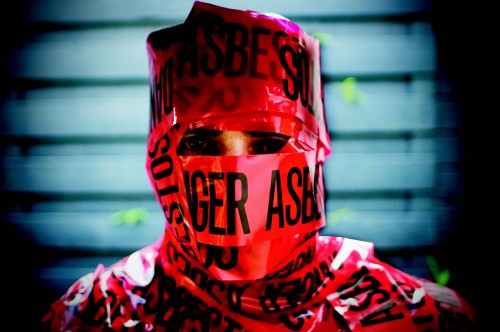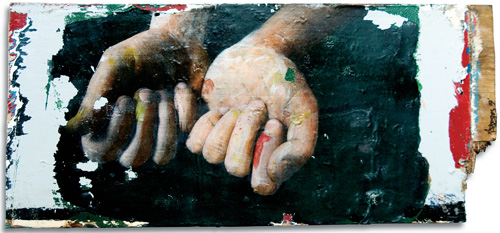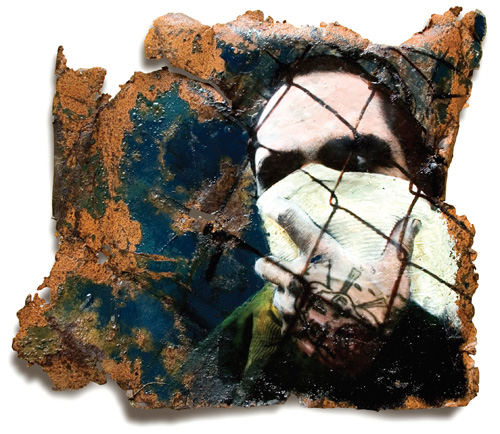 A city whose public is in a constant state of expression is a sign of freedom. This is the attitude of Dublin-based street artist Asbestos, who believes that the practice of graffiti and street art not only puts work into the public sphere, but also constantly challenges and defines what ‘public’ is. “Tagging is the life blood of a city,” he explains, “a ‘clean’ city feels as if no one has any freedom, it feels as if a population has given up on expressing themselves.” His moniker is taken from the poisonous material that, once identified, is considered an infestation. The same is true for street art. “It becomes a visual avalanche, you realize that it’s all around you, art, paint, stickers, the more you look the more you see.” From the simple and immediate tag that denotes ‘I was here,’ to the more elaborate graffiti that graces the alleyways and crevices of city streets, these visual markings are evidence that a city is alive and pulsing.
A city whose public is in a constant state of expression is a sign of freedom. This is the attitude of Dublin-based street artist Asbestos, who believes that the practice of graffiti and street art not only puts work into the public sphere, but also constantly challenges and defines what ‘public’ is. “Tagging is the life blood of a city,” he explains, “a ‘clean’ city feels as if no one has any freedom, it feels as if a population has given up on expressing themselves.” His moniker is taken from the poisonous material that, once identified, is considered an infestation. The same is true for street art. “It becomes a visual avalanche, you realize that it’s all around you, art, paint, stickers, the more you look the more you see.” From the simple and immediate tag that denotes ‘I was here,’ to the more elaborate graffiti that graces the alleyways and crevices of city streets, these visual markings are evidence that a city is alive and pulsing.
As cathartic as it can be, graffiti is also illegal. Hence artists who work in this way battle the limitations of the law as well as moonlight. On the streets, the most intricate work is guided by a quiet glow. Graffiti artists must remain invisible while making something as visible as possible; once the sun rises, walls expose works high above eye level, new characters emerge, and designs shimmer. Graffiti artists also battle time-working quickly, but also hoping that their designs remain on the wall for as long as possible before being painted over. Asbestos recognizes the risk as inherent in the relationship he has to his workspace. “Once you put work on the street you can’t be pious about it. You are doing something to someone else’s property. It’s up to me to put it in as difficult a spot as possible-that is my job. It’s part of the interaction.”
Interaction is a key element in Asbestos’ work, and also part of what delineates street art from other forms of work like graffiti or tagging. Popularized by London artist Banksy, street art plays conceptually with the intersection between definitions of art and public space. Many street artists work within the paradigms of fine art practice and bring them to the street, to a grassroots level where what is deemed “art” can be appreciated publicly, outside of the gallery, and free of charge. For Asbestos this means a balance between high-quality, lasting materials and the gritty, changing nature of the street venue.
In his Dolls series, Asbestos spends time in his studio producing small paintings of dolls heads, applying gold leaf to plaster and sheetrock to images of dolls heads whose eyes have been concealed by a black censoring strip. These small paintings are distributed high and low throughout the city-one is visible just above a staircase and goes unnoticed by an amorous couple in embrace. Another is placed high above the street on a telephone pole, the gold leaf is radiant against weathered wood. Dolls become gems that dot the street, waiting for a pair of eyes to recognize their sightless faces. Asbestos uses gold leaf to expose the unspoken guidelines about “art,” what belongs in the gallery versus what belongs in the street. “Using gold leaf on the street doesn’t make sense to a lot of people. To me it’s about putting pure craft and quality and making it something that is a real jewel, something that really sparkles, that stands out, that looks like as if shouldn’t be there.”
In his Lost series, Asbestos does just the opposite. He uses the language of lost posters-those earnest fliers that layer telephone poles-to highlight things that normally don’t stand out. “I like the idea of subverting the idea of possessions,” Asbestos says. One of the first works in his Lost series reads, “Lost: One Polaroid of a small dog. Last seen on the photocopier I copied this poster on.” Others include Lost Toast (“Last seen on my plate a minute ago”), Lost Stapler, Lost Weight, and Lost Telephone Pole, that displays an image of the very pole the poster is tacked onto. Each poster is equipped with a contact email in case anything is ‘found,’ and this has added a layer of complexity to his desire for public interaction. Once someone emailed him a photograph of him/herself holding onto a telephone pole, exclaiming, “I’ve found your telephone pole, and you’re not getting it back!” This kind of response drives Asbestos’ work. “If the public gets a reaction to [the work], that’s where my starting point is. To occasionally see people smiling, or puzzled; it is a buzz to see people reacting to the work.”
Street art highlights things that “shouldn’t be there,” but the emphasis is not the object itself. Often, as we see in Banksy’s work, what is exposed are the mechanics of the city itself-the hierarchies, the authority figures, the hidden dos and don’ts of the supposed “public” sphere. A stenciled phrase “What are you looking at?” is positioned just below the gaze of a surveillance camera in one of Banksy’s punster moves. Asbestos is more focused on the city’s psychology by inciting aesthetic interactions with his viewers. He explains, “I try and work within my own parameters. My reason is not overtly political; it’s more about the art itself, the craft itself. And I want to get a reaction from people.” While the interaction to which refers is part of what separates the label “street art” from “graffiti” or “tagging,” this delineation is fraught with difficulty in the mind of the practicing artist. “It’s very easy to ascribe names to things, but for all intents and purposes, yeah I’m a street artist. Does it matter? Not really. It’s more important to that you’re out doing work rather than worrying about what it’s called.”
– Analisa Goodin
See more Asbestos artwork at Carmichael Gallery of Contemporary Art in Los Angeles. The art of Asbestos will be on view in TAKE A DEEP BREATH, June 21 – July 20, 2008 at Carmichael Gallery of Contemporary Art, www.carmichaelgallery.com
Asbestos: www.theartofasbestos.com



